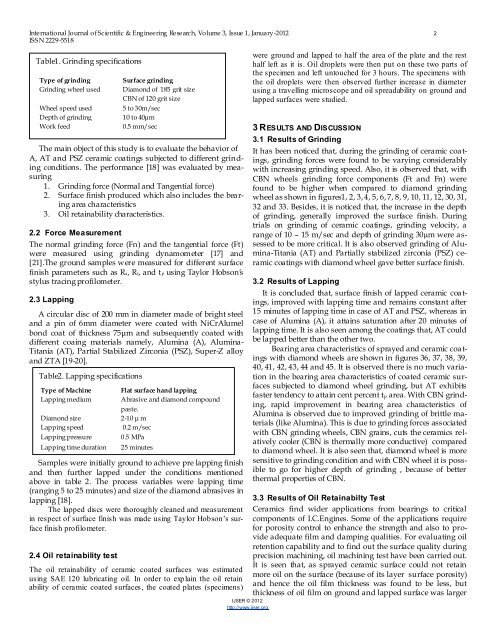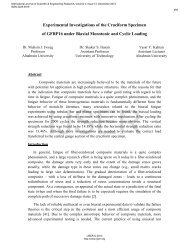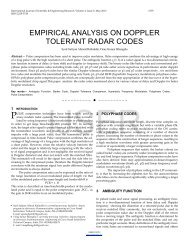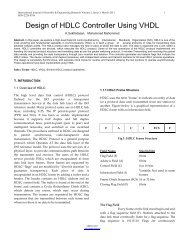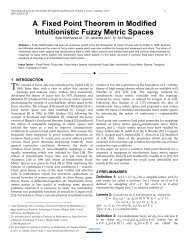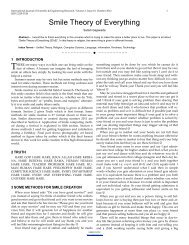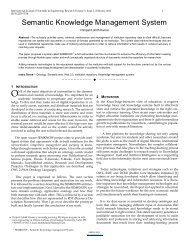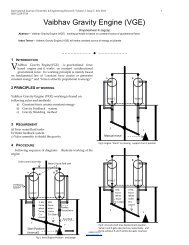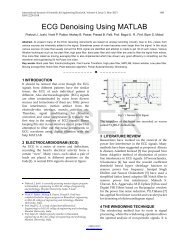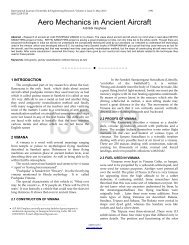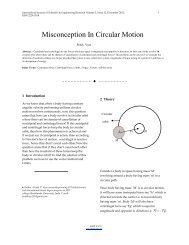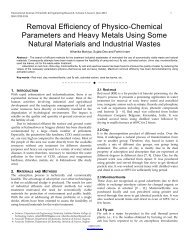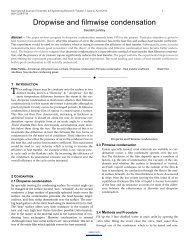Parametric influence on cutting parameters characteristics in ...
Parametric influence on cutting parameters characteristics in ...
Parametric influence on cutting parameters characteristics in ...
You also want an ePaper? Increase the reach of your titles
YUMPU automatically turns print PDFs into web optimized ePapers that Google loves.
Internati<strong>on</strong>al Journal of Scientific & Eng<strong>in</strong>eer<strong>in</strong>g Research, Volume 3, Issue 1, January-2012 2<br />
ISSN 2229-5518<br />
Table1. Gr<strong>in</strong>d<strong>in</strong>g specificati<strong>on</strong>s<br />
Type of gr<strong>in</strong>d<strong>in</strong>g Surface gr<strong>in</strong>d<strong>in</strong>g<br />
Gr<strong>in</strong>d<strong>in</strong>g wheel used Diam<strong>on</strong>d of 185 grit size<br />
CBN of 120 grit size<br />
Wheel speed used 5 to 30m/sec<br />
Depth of gr<strong>in</strong>d<strong>in</strong>g 10 to 40μm<br />
Work feed 0.5 mm/sec<br />
The ma<strong>in</strong> object of this study is to evaluate the behavior of<br />
A, AT and PSZ ceramic coat<strong>in</strong>gs subjected to different gr<strong>in</strong>d<strong>in</strong>g<br />
c<strong>on</strong>diti<strong>on</strong>s. The performance [18] was evaluated by measur<strong>in</strong>g<br />
1. Gr<strong>in</strong>d<strong>in</strong>g force (Normal and Tangential force)<br />
2. Surface f<strong>in</strong>ish produced which also <strong>in</strong>cludes the bear<strong>in</strong>g<br />
area <strong>characteristics</strong><br />
3. Oil reta<strong>in</strong>ability <strong>characteristics</strong>.<br />
2.2 Force Measurement<br />
The normal gr<strong>in</strong>d<strong>in</strong>g force (Fn) and the tangential force (Ft)<br />
were measured us<strong>in</strong>g gr<strong>in</strong>d<strong>in</strong>g dynamometer [17] and<br />
[21].The ground samples were measured for different surface<br />
f<strong>in</strong>ish <strong>parameters</strong> such as Ra, Rt, and t p us<strong>in</strong>g Taylor Hobs<strong>on</strong>’s<br />
stylus trac<strong>in</strong>g profilometer.<br />
2.3 Lapp<strong>in</strong>g<br />
A circular disc of 200 mm <strong>in</strong> diameter made of bright steel<br />
and a p<strong>in</strong> of 6mm diameter were coated with NiCrAlumel<br />
b<strong>on</strong>d coat of thickness 75μm and subsequently coated with<br />
different coa<strong>in</strong>g materials namely, Alum<strong>in</strong>a (A), Alum<strong>in</strong>a-<br />
Titania (AT), Partial Stabilized Zirc<strong>on</strong>ia (PSZ), Super-Z alloy<br />
and ZTA [19-20].<br />
Table2. Lapp<strong>in</strong>g specificati<strong>on</strong>s<br />
Type of Mach<strong>in</strong>e Flat surface hand lapp<strong>in</strong>g<br />
Lapp<strong>in</strong>g medium Abrasive and diam<strong>on</strong>d compound<br />
paste.<br />
Diam<strong>on</strong>d size 2-10 μ m<br />
Lapp<strong>in</strong>g speed 0.2 m/sec<br />
Lapp<strong>in</strong>g pressure 0.5 MPa<br />
Lapp<strong>in</strong>g time durati<strong>on</strong> 25 m<strong>in</strong>utes<br />
Samples were <strong>in</strong>itially ground to achieve pre lapp<strong>in</strong>g f<strong>in</strong>ish<br />
and then further lapped under the c<strong>on</strong>diti<strong>on</strong>s menti<strong>on</strong>ed<br />
above <strong>in</strong> table 2. The process variables were lapp<strong>in</strong>g time<br />
(rang<strong>in</strong>g 5 to 25 m<strong>in</strong>utes) and size of the diam<strong>on</strong>d abrasives <strong>in</strong><br />
lapp<strong>in</strong>g [18].<br />
The lapped discs were thoroughly cleaned and measurement<br />
<strong>in</strong> respect of surface f<strong>in</strong>ish was made us<strong>in</strong>g Taylor Hobs<strong>on</strong>’s surface<br />
f<strong>in</strong>ish profilometer.<br />
2.4 Oil reta<strong>in</strong>ability test<br />
The oil reta<strong>in</strong>ability of ceramic coated surfaces was estimated<br />
us<strong>in</strong>g SAE 120 lubricat<strong>in</strong>g oil. In order to expla<strong>in</strong> the oil reta<strong>in</strong><br />
ability of ceramic coated surfaces, the coated plates (specimens)<br />
IJSER © 2012<br />
http://www.ijser.org<br />
were ground and lapped to half the area of the plate and the rest<br />
half left as it is. Oil droplets were then put <strong>on</strong> these two parts of<br />
the specimen and left untouched for 3 hours. The specimens with<br />
the oil droplets were then observed further <strong>in</strong>crease <strong>in</strong> diameter<br />
us<strong>in</strong>g a travell<strong>in</strong>g microscope and oil spreadability <strong>on</strong> ground and<br />
lapped surfaces were studied.<br />
3 RESULTS AND DISCUSSION<br />
3.1 Results of Gr<strong>in</strong>d<strong>in</strong>g<br />
It has been noticed that, dur<strong>in</strong>g the gr<strong>in</strong>d<strong>in</strong>g of ceramic coat<strong>in</strong>gs,<br />
gr<strong>in</strong>d<strong>in</strong>g forces were found to be vary<strong>in</strong>g c<strong>on</strong>siderably<br />
with <strong>in</strong>creas<strong>in</strong>g gr<strong>in</strong>d<strong>in</strong>g speed. Also, it is observed that, with<br />
CBN wheels gr<strong>in</strong>d<strong>in</strong>g force comp<strong>on</strong>ents (Ft and Fn) were<br />
found to be higher when compared to diam<strong>on</strong>d gr<strong>in</strong>d<strong>in</strong>g<br />
wheel as shown <strong>in</strong> figures1, 2, 3, 4, 5, 6, 7, 8, 9, 10, 11, 12, 30, 31,<br />
32 and 33. Besides, it is noticed that, the <strong>in</strong>crease <strong>in</strong> the depth<br />
of gr<strong>in</strong>d<strong>in</strong>g, generally improved the surface f<strong>in</strong>ish. Dur<strong>in</strong>g<br />
trials <strong>on</strong> gr<strong>in</strong>d<strong>in</strong>g of ceramic coat<strong>in</strong>gs, gr<strong>in</strong>d<strong>in</strong>g velocity, a<br />
range of 10 – 15 m/sec and depth of gr<strong>in</strong>d<strong>in</strong>g 30µm were assessed<br />
to be more critical. It is also observed gr<strong>in</strong>d<strong>in</strong>g of Alum<strong>in</strong>a-Titania<br />
(AT) and Partially stabilized zirc<strong>on</strong>ia (PSZ) ceramic<br />
coat<strong>in</strong>gs with diam<strong>on</strong>d wheel gave better surface f<strong>in</strong>ish.<br />
3.2 Results of Lapp<strong>in</strong>g<br />
It is c<strong>on</strong>cluded that, surface f<strong>in</strong>ish of lapped ceramic coat<strong>in</strong>gs,<br />
improved with lapp<strong>in</strong>g time and rema<strong>in</strong>s c<strong>on</strong>stant after<br />
15 m<strong>in</strong>utes of lapp<strong>in</strong>g time <strong>in</strong> case of AT and PSZ, whereas <strong>in</strong><br />
case of Alum<strong>in</strong>a (A), it atta<strong>in</strong>s saturati<strong>on</strong> after 20 m<strong>in</strong>utes of<br />
lapp<strong>in</strong>g time. It is also seen am<strong>on</strong>g the coat<strong>in</strong>gs that, AT could<br />
be lapped better than the other two.<br />
Bear<strong>in</strong>g area <strong>characteristics</strong> of sprayed and ceramic coat<strong>in</strong>gs<br />
with diam<strong>on</strong>d wheels are shown <strong>in</strong> figures 36, 37, 38, 39,<br />
40, 41, 42, 43, 44 and 45. It is observed there is no much variati<strong>on</strong><br />
<strong>in</strong> the bear<strong>in</strong>g area <strong>characteristics</strong> of coated ceramic surfaces<br />
subjected to diam<strong>on</strong>d wheel gr<strong>in</strong>d<strong>in</strong>g, but AT exhibits<br />
faster tendency to atta<strong>in</strong> cent percent tp area. With CBN gr<strong>in</strong>d<strong>in</strong>g,<br />
rapid improvement <strong>in</strong> bear<strong>in</strong>g area <strong>characteristics</strong> of<br />
Alum<strong>in</strong>a is observed due to improved gr<strong>in</strong>d<strong>in</strong>g of brittle materials<br />
(like Alum<strong>in</strong>a). This is due to gr<strong>in</strong>d<strong>in</strong>g forces associated<br />
with CBN gr<strong>in</strong>d<strong>in</strong>g wheels, CBN gra<strong>in</strong>s, cuts the ceramics relatively<br />
cooler (CBN is thermally more c<strong>on</strong>ductive) compared<br />
to diam<strong>on</strong>d wheel. It is also seen that, diam<strong>on</strong>d wheel is more<br />
sensitive to gr<strong>in</strong>d<strong>in</strong>g c<strong>on</strong>diti<strong>on</strong> and with CBN wheel it is possible<br />
to go for higher depth of gr<strong>in</strong>d<strong>in</strong>g , because of better<br />
thermal properties of CBN.<br />
3.3 Results of Oil Reta<strong>in</strong>abilty Test<br />
Ceramics f<strong>in</strong>d wider applicati<strong>on</strong>s from bear<strong>in</strong>gs to critical<br />
comp<strong>on</strong>ents of I.C.Eng<strong>in</strong>es. Some of the applicati<strong>on</strong>s require<br />
for porosity c<strong>on</strong>trol to enhance the strength and also to provide<br />
adequate film and damp<strong>in</strong>g qualities. For evaluat<strong>in</strong>g oil<br />
retenti<strong>on</strong> capability and to f<strong>in</strong>d out the surface quality dur<strong>in</strong>g<br />
precisi<strong>on</strong> mach<strong>in</strong><strong>in</strong>g, oil mach<strong>in</strong><strong>in</strong>g test have been carried out.<br />
It is seen that, as sprayed ceramic surface could not reta<strong>in</strong><br />
more oil <strong>on</strong> the surface (because of its layer surface porosity)<br />
and hence the oil film thickness was found to be less, but<br />
thickness of oil film <strong>on</strong> ground and lapped surface was larger


